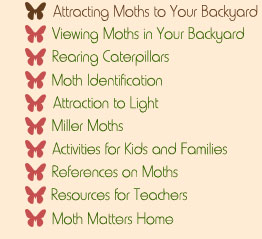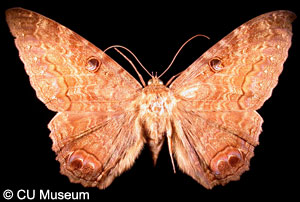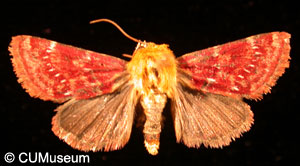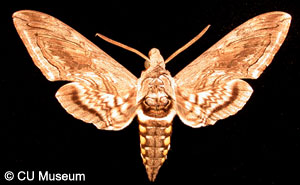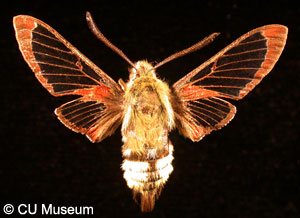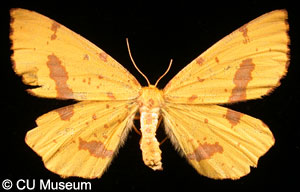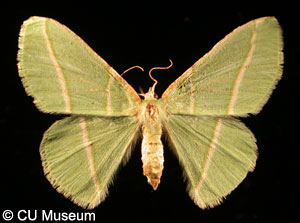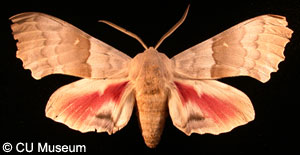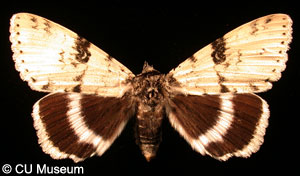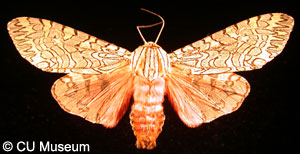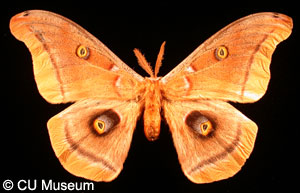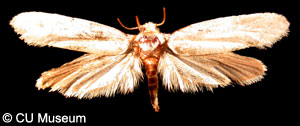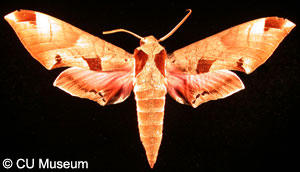|
In Colorado, moths are numerous and diverse, with an estimated 5000 species in the state. Chances are you already have many species of moths living in or visiting your backyard; however, there are a few things you can do to attract them. You can increase the diversity of native plant species in your yard. Even a small patch of native plants will help. You can plant flowers that provide nectar on which moths can feed. If you have no room to garden, you can still provide your moths with a nighttime snack. (See our tips on "sugaring")
Once you have them in your yard, try not to kill them inadvertently. Avoid bugzappers; they are a menace to the insect world. Limit or do not use pesticides, including Bt (Bacillus thuringiensis). Remember caterpillars are juvenile moths (and butterflies), so be willing to accept a small amount of feeding damage on leaves.
Event Announcement:
To get a perspective on how many species occur in the Boulder area, come to Dr. Paul Opler's lecture entitled "The Exciting World of Colorado Moths" on April 7th at 7pm.
Here are some examples of moths that might be attracted to your backyard if you live in Colorado's Front Range.
Ascalapha odorata, the black witch, reproduces in Mexico, not Colorado, but is a very strong flier and comes up from Mexico on summer storms. This impressive moth is one of the largest we see in the front range of the Rocky Mountains. It will come to lights or take shelter in dark places such as garages.
To find out more about this moth's distribution, check out the USGS's Moths of North America web page for Ascalapha odorata.
Schinia masoni adults and caterpillars are found only on blanket-flowers ( Gaillardia aristata) where, despite its bright colors the adult moth is very well camouflaged. It will position itself so that its reddish wings are over the red disk flowers and its golden thorax is resting above the golden ray flowers.
To find out more about this moth's distribution and to see how it camouflages itself, check out the USGS's Moths of North America web page for Schinia masoni.
Manduca quinquemaculata, the five-spotted hawkmoth, is the adult of the tomato hornworm. This species and another closely related species are the culprits that devour tomato plants in home gardens.
To find out more facts about this moth and its distribution, check out the USGS's Moths of North America web page for Manduca quinquemaculata.
Hemaris senta, the rocky mountain clearwing, is a bumble bee mimic that can be seen nectaring on flowers all summer long.
To find out more about this moth's distribution, check out the USGS's Moths of North America web page for Hemaris senta.
Xanthotype sp. can be found in grassy meadows during mid-summer. The caterpillars are one of the many kinds of inchworms.
Dichorda rectaria caterpillars feed on Skunkbrush ( Rhus trilobata). The adult moths come to porch lights.
Pachysphinx modesta, the big poplar sphinx, is a very large moth. The caterpillars feed on cottonwood leaves. This moth is on the Colorado Natural Heritage Program's "special concern list."
For more information on this moth and its distribution, check out the USGS's Moths of America web site for Pachysphinx modesta.
Catocala relicta, the white underwing, spends its days sitting on aspen tree trunks, where it is camouflaged.
Arachnis picta, the painted tiger moth, is brightly colored. Many moths in this family are brightly colored, warning birds that they taste bad.
For more information on this moth and its distribution, check out the USGS's Moths of America web site for Arachnis picta.
Antheraea polyphemus, the polyphemus, is one of the native giant silk moths and a close relative to the Cecropia. Adults do not feed, but do come to porch lights. Look for them in June.
For more information on this moth and its distribution, check out the USGS's Moths of America web site for Antheraea polyphemus.
Tegeticula yuccasella, the yucca moth, has a lifecycle tied to the yucca plant. Look for these white moths on the yucca's white flowers.
Eumorpha achemon, the achemon sphinx, is a beautiful species. Its caterpillars feed on grapevines.
For more information on this moth and its distribution, check out the USGS's Moths of America web site for Eumorpha achemon.
[ Return to Top ]
|

